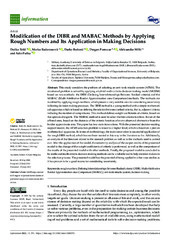Please use this identifier to cite or link to this item:
https://rfos.fon.bg.ac.rs/handle/123456789/2350| Title: | Modification of the DIBR and MABAC Methods by Applying Rough Numbers and Its Application in Making Decisions | Authors: | Tešić, Duško Radovanović, Marko Božanić, Darko Pamučar, Dragan Milić, Aleksandar Puska, Adis |
Keywords: | rough numbers;Multi-Attributive Border Approximation area Comparison (MABAC);Defining Interrelationships Between Ranked criteria (DIBR);decision-making;anti-tank missile system | Issue Date: | 2022 | Publisher: | MDPI, Basel | Abstract: | This study considers the problem of selecting an anti-tank missile system (ATMS). The mentioned problem is solved by applying a hybrid multi-criteria decision-making model (MCDM) based on two methods: the DIBR (Defining Interrelationships Between Ranked criteria) and the MABAC (Multi-Attributive Border Approximation area Comparison) methods. The methods are modified by applying rough numbers, which present a very suitable area for considering uncertainty following decision-making processes. The DIBR method is a young method with a simple mathematical apparatus which is based on defining the relation between ranked criteria, that is, adjacent criteria, reducing the number of comparisons. This method defines weight coefficients of criteria, based on the opinion of experts. The MABAC method is used to select the best alternative from the set of the offered ones, based on the distance of the criteria function of every observed alternative from the border approximate area. The paper has two main innovations. With the presented decision-making support model, the ATMS selection problem is raised to a higher level, which is based on a proven mathematical apparatus. In terms of methodology, the main innovation is successful application of the rough DIBR method, which has not been treated in this way in the literature so far. Additionally, an analysis of the literature related to the research problem as well as to the methods used is carried out. After the application of the model, the sensitivity analysis of the output results of the presented model to the change of the weight coefficients of criteria is performed, as well as the comparison of the results of the presented model with other methods. Finally, the proposed model is concluded to be stable and multi-criteria decision-making methods can be a reliable tool to help decision makers in the selection process. The presented model has the potential of being applied in other case studies as it has proven to be a good means for considering uncertainty. | URI: | https://rfos.fon.bg.ac.rs/handle/123456789/2350 | ISSN: | 2078-2489 |
| Appears in Collections: | Radovi istraživača / Researchers’ publications |
Show full item record
SCOPUSTM
Citations
19
checked on Nov 17, 2025
Page view(s)
6
checked on Dec 14, 2025
Google ScholarTM
Check
Altmetric
This item is licensed under a Creative Commons License


